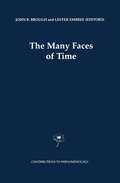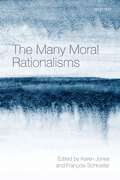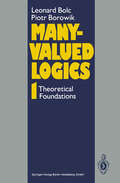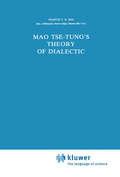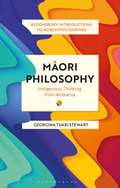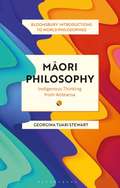- Table View
- List View
The Many Faces of Philosophy: Reflections from Plato to Arendt
by Amélie Oksenberg RortyPhilosophy is a dangerous profession, risking censorship, prison, even death. And no wonder: philosophers have questioned traditional pieties and threatened the established political order. Some claimed to know what was thought unknowable; others doubted what was believed to be certain. Some attacked religion in the name of science; others attacked science in the name of mystical poetry; some served tyrants; others were radical revolutionaries. This historically based collection of philosophers' reflections--the letters, journals, prefaces that reveal their hopes and hesitations, their triumphs and struggles, their deepest doubts and convictions--allow us to witness philosophical thought-in-process. It sheds light on the many--and conflicting--aims of philosophy: to express skepticism or overcome it, to support theology or attack it, to develop an ethical system or reduce it to practical politics. As their audiences differed, philosophers experimented with distinctive rhetorical strategies, writing dialogues, meditations, treatises, aphorisms. Ranging from Plato to Hannah Arendt, with contributions from 44 philosophers (Augustine, Maimonides, AlGhazali, Descartes, Pascal, Leibniz, Voltaire, Rousseau, Hobbes, Hume, Kant, Nietzsche, Kierkegaard, Wittgenstein, among others) this remarkable collection documents philosophers' claim that they change as well as understand the world. In her introductory essay, "Witnessing Philosophers," Amelie Rorty locates philosophers' reflections in the larger context of the many facets of their other activities and commitments.
The Many Faces Of Science: An Introduction To Scientists, Values, And Society
by Henry ByerlyThe development of modern science, and its increasing impact on our lives and cultures, is one of the great stories of our time. So, understanding--and coming to terms with--the institution of modern science should be an integral part of education. In The Many Faces of Science, Leslie Stevenson and Henry Byerly masterfully, and painlessly, provide the basic information and the philosophical reflection students need to gain such understanding. The authors make good use of case study methods, and they introduce us to dozens of figures from the history of science. Stevenson and Byerly provide an elementary sketch of the development of science through the lives of its practitioners, and they examine the often mixed motives of scientists, as well as the conflicting values people bring to science--and to their perceptions of its impact on society. The authors also explore the relationship between scientific practice and political and economic power.Accessible and rich with anecdotes, personal asides, and keen insight, The Many Faces of Science is the ideal interdisciplinary introduction for nonscientists in courses on science studies, science and society, and science and human values. It will also prove useful as supplementary reading in courses on science and philosophy, sociology, and political science. In this second edition of The Many Faces of Science, the authors have updated topics that they explore in the first edition, and they present new case studies on subjects such as HIV and AIDS, women in science, and work done in psychology and the social sciences. The authors also extend their discussion of science and values, in addition to revising their study of science and technology to emphasize changes in scientific practice today.
The Many Faces Of Science: An Introduction To Scientists, Values, And Society
by Henry ByerlyThe development of modern science, and its increasing impact on our lives and cultures, is one of the great stories of our time. So, understanding--and coming to terms with--the institution of modern science should be an integral part of education. In The Many Faces of Science, Leslie Stevenson and Henry Byerly masterfully, and painlessly, provide the basic information and the philosophical reflection students need to gain such understanding. The authors make good use of case study methods, and they introduce us to dozens of figures from the history of science. Stevenson and Byerly provide an elementary sketch of the development of science through the lives of its practitioners, and they examine the often mixed motives of scientists, as well as the conflicting values people bring to science--and to their perceptions of its impact on society. The authors also explore the relationship between scientific practice and political and economic power.Accessible and rich with anecdotes, personal asides, and keen insight, The Many Faces of Science is the ideal interdisciplinary introduction for nonscientists in courses on science studies, science and society, and science and human values. It will also prove useful as supplementary reading in courses on science and philosophy, sociology, and political science. In this second edition of The Many Faces of Science, the authors have updated topics that they explore in the first edition, and they present new case studies on subjects such as HIV and AIDS, women in science, and work done in psychology and the social sciences. The authors also extend their discussion of science and values, in addition to revising their study of science and technology to emphasize changes in scientific practice today.
The Many Faces of Time (Contributions to Phenomenology #41)
by LesterEmbree John B. BroughTemporality has been a central issue in phenomenology since its inception. Husserl's groundbreaking investigations of the consciousness of internal time early in the century inaugurated a phenomenological tradition enriched by such figures as Martin Heidegger, Jean-Paul Sartre, Maurice Merleau-Ponty, and Eugen Fink. The authors of the essays collected in this volume continue that tradition, challenging, expanding, and deepening it. Many of the essays explore topics involving the deepest levels of temporal constitution, including the relationship of temporality to the self and to the world; the ways in which temporalizing consciousness and what it temporalizes present themselves; and the roles and nature of present, past, and future. Other essays develop original positions concerning history, tradition, narrative, the time of generations, the coherence of one's life, and the place of time in the visual arts. In every instance, the authors show how invaluable phenomenology is for the investigation of time's many faces.
The Many Futures of a Decision
by Jay LampertCombining two a central topics in philosophy in the 20th Century, this book considers the ethics and impact of decision-making alongside the philosophy of time.When we make simple decisions, like the decision to wake up at 8 a.m. tomorrow, we make use of a linear model of the future. But when we make open-ended decisions, like the decision to get fitter, or more involved in politics, we presuppose a much more complex model of the future. We project a variety of virtual futures. We can carry out a decision in many different ways at once, which may converge and diverge at different points in time. Using a phenomenological approach, The Many Futures of a Decision explores what we learn about the structure of the future specifically from decision-making. Most theories of decision concentrate on the rationality: the evidence and value assessments that build up grounds for a rational decision. Instead, this book innovatively engages with the nature of the future as a multi-layered decisions project. Through interpretations of the theories of decision in philosophers like Husserl and Heidegger, Schmitt and Habermas, Derrida and Deleuze, along with other decision theories, Lampert develops an original theory of multiple futures.
The Many Futures of a Decision
by Jay LampertCombining two a central topics in philosophy in the 20th Century, this book considers the ethics and impact of decision-making alongside the philosophy of time.When we make simple decisions, like the decision to wake up at 8 a.m. tomorrow, we make use of a linear model of the future. But when we make open-ended decisions, like the decision to get fitter, or more involved in politics, we presuppose a much more complex model of the future. We project a variety of virtual futures. We can carry out a decision in many different ways at once, which may converge and diverge at different points in time. Using a phenomenological approach, The Many Futures of a Decision explores what we learn about the structure of the future specifically from decision-making. Most theories of decision concentrate on the rationality: the evidence and value assessments that build up grounds for a rational decision. Instead, this book innovatively engages with the nature of the future as a multi-layered decisions project. Through interpretations of the theories of decision in philosophers like Husserl and Heidegger, Schmitt and Habermas, Derrida and Deleuze, along with other decision theories, Lampert develops an original theory of multiple futures.
Many Layers of Ecocentrism: Revering Life, Revering the Earth
by Abhik GuptaThis book unveils the myriad streams of ecocentric thoughts that have been flowing through the human mind – in indigenous communities, in the wisdom of philosophers, in the creative expressions of poets and writers – sometimes latent, but sometimes more explicit. The strength of this book lies in the fact that it attempts to show that ecocentrism had not emerged suddenly as a distinct line of philosophical thought or found its place among the various normative approaches toward nature, but the seeds of ecocentrism had always been running through human societies. Thus, this book not only emphasizes the “unity of life” but also reveals the inherent unity of all hues of ecocentrism. The book adopts a multidisciplinary approach, which is essential to dwell on a topic like ecocentrism which permeates the domains of disciplines as disparate as science, philosophy, religion, normative ethics, myths and folklore, poetry, and literature, among others. Despite this eclectic approach, the book attempts to maintain continuity among the chapters and present these concepts in a simple form that will be easily accessible by readers from all conceivable backgrounds. This book would be useful to the students, researchers, and faculty from the fields of ecology and environmental science, philosophy, sociology, religious studies, and literature. It will also be an indispensable companion for all nature lovers, activists, and general readers interested in the emergence and evolution of environmental thoughts.
Many Layers of Ecocentrism: Revering Life, Revering the Earth
by Abhik GuptaThis book unveils the myriad streams of ecocentric thoughts that have been flowing through the human mind – in indigenous communities, in the wisdom of philosophers, in the creative expressions of poets and writers – sometimes latent, but sometimes more explicit. The strength of this book lies in the fact that it attempts to show that ecocentrism had not emerged suddenly as a distinct line of philosophical thought or found its place among the various normative approaches toward nature, but the seeds of ecocentrism had always been running through human societies. Thus, this book not only emphasizes the “unity of life” but also reveals the inherent unity of all hues of ecocentrism. The book adopts a multidisciplinary approach, which is essential to dwell on a topic like ecocentrism which permeates the domains of disciplines as disparate as science, philosophy, religion, normative ethics, myths and folklore, poetry, and literature, among others. Despite this eclectic approach, the book attempts to maintain continuity among the chapters and present these concepts in a simple form that will be easily accessible by readers from all conceivable backgrounds. This book would be useful to the students, researchers, and faculty from the fields of ecology and environmental science, philosophy, sociology, religious studies, and literature. It will also be an indispensable companion for all nature lovers, activists, and general readers interested in the emergence and evolution of environmental thoughts.
The many lives of corruption: The reform of public life in modern Britain, <i>c.</i> 1750–1950
by Tom Crook Ian CawoodHow has corruption shaped – and undermined – the history of public life in modern Britain? This collection begins the task of piecing together this history over the past two and a half centuries, from the first assaults on Old Corruption and aristocratic privilege during the late eighteenth century through to the corruption scandals that blighted the worlds of Westminster and municipal government during the twentieth century. It offers the first account that pays equal attention to the successes and limitations of anticorruption reforms and the shifting meanings of ‘corruption’. It does so across a range of different sites – electoral, political and administrative, domestic and colonial – presenting new research on neglected areas of reform, while revisiting well known scandals and corrupt practices.
The many lives of corruption: The reform of public life in modern Britain, <i>c.</i> 1750–1950
by Ian Cawood and Tom CrookHow has corruption shaped – and undermined – the history of public life in modern Britain? This collection begins the task of piecing together this history over the past two and a half centuries, from the first assaults on Old Corruption and aristocratic privilege during the late eighteenth century through to the corruption scandals that blighted the worlds of Westminster and municipal government during the twentieth century. It offers the first account that pays equal attention to the successes and limitations of anticorruption reforms and the shifting meanings of ‘corruption’. It does so across a range of different sites – electoral, political and administrative, domestic and colonial – presenting new research on neglected areas of reform, while revisiting well known scandals and corrupt practices.
The Many Moral Rationalisms
by Karen Jones François SchroeterMoral rationalism takes human reason and human rationality to be the key elements in an explanation of the nature of morality, moral judgment, and moral knowledge. This volume explores the resources of this rich philosophical tradition. Thirteen original essays, framed by the editors' introduction, critically examine the four core theses of moral rationalism: (i) the psychological thesis that reason is the source of moral judgment, (ii) the metaphysical thesis that moral requirements are constituted by the deliverances of practical reason, (iii) the epistemological thesis that moral requirements are knowable a priori, and (iv) the normative thesis that moral requirements entail valid reasons for action. The five essays in Part I ('Normativity') offer contemporary defences or reconstructions of Kant's attempt to ground the normative thesis, that moral requirements entail valid reasons for action, in the nature of practical reason and practical rationality. The four essays in Part II ('Epistemology & Meaning') consider the viability of claims to a priori moral knowledge. The authors of all four essays are sympathetic to a realist moral metaphysics, and thus forgo the straightforward constructivist road to apriority. The four essays in Part III ('Psychology') each grapple with the implications for rationalism of the role of emotions and unconscious processes in moral judgement and action. Together the essays demonstrate that moral rationalism identifies not a single philosophical position but rather a family of philosophical positions, which resemble traditional rationalism, as exemplified by Kant, to varying degrees.
The Many Moral Rationalisms
Moral rationalism takes human reason and human rationality to be the key elements in an explanation of the nature of morality, moral judgment, and moral knowledge. This volume explores the resources of this rich philosophical tradition. Thirteen original essays, framed by the editors' introduction, critically examine the four core theses of moral rationalism: (i) the psychological thesis that reason is the source of moral judgment, (ii) the metaphysical thesis that moral requirements are constituted by the deliverances of practical reason, (iii) the epistemological thesis that moral requirements are knowable a priori, and (iv) the normative thesis that moral requirements entail valid reasons for action. The five essays in Part I ('Normativity') offer contemporary defences or reconstructions of Kant's attempt to ground the normative thesis, that moral requirements entail valid reasons for action, in the nature of practical reason and practical rationality. The four essays in Part II ('Epistemology & Meaning') consider the viability of claims to a priori moral knowledge. The authors of all four essays are sympathetic to a realist moral metaphysics, and thus forgo the straightforward constructivist road to apriority. The four essays in Part III ('Psychology') each grapple with the implications for rationalism of the role of emotions and unconscious processes in moral judgement and action. Together the essays demonstrate that moral rationalism identifies not a single philosophical position but rather a family of philosophical positions, which resemble traditional rationalism, as exemplified by Kant, to varying degrees.
Many Sides: A Protagorean Approach to the Theory, Practice and Pedagogy of Argument (Argumentation Library #5)
by M. MendelsonMany Sides is the first full-length study of Protagorean antilogic, an argumentative practice with deep roots in rhetorical history and renewed relevance for contemporary culture. Founded on the philosophical relativism of Protagoras, antilogic is a dynamic rather than a formal approach to argument, focused principally on the dialogical interaction of opposing positions (anti-logoi) in controversy. In ancient Athens, antilogic was the cardinal feature of Sophistic rhetoric. In Rome, Cicero redefined Sophistic argument in a concrete set of dialogical procedures. In turn, Quintilian inherited this dialogical tradition and made it the centrepiece of his own rhetorical practice and pedagogy. Many Sides explores the history, theory, and pedagogy of this neglected rhetorical tradition and, by appeal to recent rhetorical and philosophical theory, reconceives the enduring features of antilogical practice in a dialogical approach to argumentation especially suited to the pluralism of our own age and the diversity of modern classrooms.
Many-Valued Logics 1: Theoretical Foundations
by Leonard Bolc Piotr BorowikMany-valued logics were developed as an attempt to handle philosophical doubts about the "law of excluded middle" in classical logic. The first many-valued formal systems were developed by J. Lukasiewicz in Poland and E.Post in the U.S.A. in the 1920s, and since then the field has expanded dramatically as the applicability of the systems to other philosophical and semantic problems was recognized. Intuitionisticlogic, for example, arose from deep problems in the foundations of mathematics. Fuzzy logics, approximation logics, and probability logics all address questions that classical logic alone cannot answer. All these interpretations of many-valued calculi motivate specific formal systems thatallow detailed mathematical treatment. In this volume, the authors are concerned with finite-valued logics, and especially with three-valued logical calculi. Matrix constructions, axiomatizations of propositional and predicate calculi, syntax, semantic structures, and methodology are discussed. Separate chapters deal with intuitionistic logic, fuzzy logics, approximation logics, and probability logics. These systems all find application in practice, in automatic inference processes, which have been decisive for the intensive development of these logics. This volume acquaints the reader with theoretical fundamentals of many-valued logics. It is intended to be the first of a two-volume work. The second volume will deal with practical applications and methods of automated reasoning using many-valued logics.
Many-valued Semantics and Modal Logics: Essays in Honour of Yuriy Vasilievich Ivlev (Synthese Library #485)
by Marcelo Esteban Coniglio Dmitry Zaitsev Ekaterina KubyshkinaThis volume is a collection of essays related to the work of Professor Yuriy Vasilievich Ivlev, a distinguished Russian logician and philosopher renowned for his expertise in many-valued and modal logics. Notably, his groundbreaking work on quasi-matrices for logics, now recognized as non-deterministic matrices and non-deterministic semantics, emerged in the 1970s. From a philosophical standpoint, Ivlev’s research delves into the formal analysis of indeterminacy, offering a logical framework to understand how sequences of indeterminate events can yield determinate outcomes. The volume follows two complementary lines of research. Firstly, it serves as a platform for the exploration and discussion of Ivlev’s seminal contributions to the algebraic characterization of both normal and non-normal modal logics, aimed at making these insights accessible to an international audience. Secondly, it features contributions from esteemed logicians and philosophers worldwide, offering diverseperspectives on the logical analysis of indeterminacy. This comprehensive volume will appeal to scholars and researchers in logic, philosophy, and mathematics who are engaged in the study of many-valued and modal methodologies for modeling situations of indeterminacy.
Many Valued Topology and its Applications
by Ulrich HöhleThe 20th Century brought the rise of General Topology. It arose from the effort to establish a solid base for Analysis and it is intimately related to the success of set theory. Many Valued Topology and Its Applications seeks to extend the field by taking the monadic axioms of general topology seriously and continuing the theory of topological spaces as topological space objects within an almost completely ordered monad in a given base category C. The richness of this theory is shown by the fundamental fact that the category of topological space objects in a complete and cocomplete (epi, extremal mono)-category C is topological over C in the sense of J. Adamek, H. Herrlich, and G.E. Strecker. Moreover, a careful, categorical study of the most important topological notions and concepts is given - e.g., density, closedness of extremal subobjects, Hausdorff's separation axiom, regularity, and compactness. An interpretation of these structures, not only by the ordinary filter monad, but also by many valued filter monads, underlines the richness of the explained theory and gives rise to new concrete concepts of topological spaces - so-called many valued topological spaces. Hence, many valued topological spaces play a significant role in various fields of mathematics - e.g., in the theory of locales, convergence spaces, stochastic processes, and smooth Borel probability measures. In its first part, the book develops the necessary categorical basis for general topology. In the second part, the previously given categorical concepts are applied to monadic settings determined by many valued filter monads. The third part comprises various applications of many valued topologies to probability theory and statistics as well as to non-classical model theory. These applications illustrate the significance of many valued topology for further research work in these important fields.
Mao Tse-Tung’s Theory of Dialectic (Sovietica #44)
by F.Y.K. SooThe year 1979 ushered in a new phase in China's long and continuous revolu tion. Currently, this new phase is being symbolically referred to, by the Chinese leaders themselves, as the 'New Long March' (a continuation of the legendary and historical Long March) in terms of modernization, which comprises the Four Modernizations: Agriculture, Industry, Science and Technology, and Military Defense. Such an all-encompassing attempt at modernization may appear, to some at least, to be something new, or may indicate a radical shift in her policy. But upon closer examination, this decision seems only to reflect an historical continuity in terms of the two major long-term goals of the Chinese Revolution: 'national independence' and 'modernization' (or 'industrialization'). The former would make China strong; the latter, wealthy. For, ever since the Opium War in 1840 and throughout the Revolutions of 1911 and 1949, China has always pursued these two revolutionary goals, though with different emphases at different times. This has been especially true during the past three decades as this twofold goal has dictated all of China's important policies, both domestic and foreign. In other words, while the concrete policies may have appeared to be lacking in unity at times, they have been formulated with the specific intent of achieving national independence and modernization. From this perspective, the New Long March marks the passage of post-Mao China beyond the transition of succession toward the continued pursuit of the same revolutionary goals.
Maoism: A Global History
by Julia LovellFor decades, the West has dismissed Maoism as an outdated historical and political phenomenon. Since the 1980s, China seems to have abandoned the utopian turmoil of Mao’s revolution in favour of authoritarian capitalism. But Mao and his ideas remain central to the People’s Republic and the legitimacy of its Communist government. With disagreements and conflicts between China and the West on the rise, the need to understand the political legacy of Mao is urgent and growing.The power and appeal of Maoism have extended far beyond China. Maoism was a crucial motor of the Cold War: it shaped the course of the Vietnam War (and the international youth rebellions that conflict triggered) and brought to power the murderous Khmer Rouge in Cambodia; it aided, and sometimes handed victory to, anti-colonial resistance movements in Africa; it inspired terrorism in Germany and Italy, and wars and insurgencies in Peru, India and Nepal, some of which are still with us today – more than forty years after the death of Mao.In this new history, Julia Lovell re-evaluates Maoism as both a Chinese and an international force, linking its evolution in China with its global legacy. It is a story that takes us from the tea plantations of north India to the sierras of the Andes, from Paris’s fifth arrondissement to the fields of Tanzania, from the rice paddies of Cambodia to the terraces of Brixton.Starting with the birth of Mao’s revolution in northwest China in the 1930s and concluding with its violent afterlives in South Asia and resurgence in the People’s Republic today, this is a landmark history of global Maoism.
Maori Philosophy: Indigenous Thinking from Aotearoa (Bloomsbury Introductions to World Philosophies)
by Georgina StewartCovering the symbolic systems and worldviews of the Indigenous peoples of Aotearoa, New Zealand, this book is a concise introduction to Maori philosophy. It addresses core philosophical issues including Maori notions of the self, the world, epistemology, the form in which Maori philosophy is conveyed, and whether or not Maori philosophy has a teleological agenda. Introducing students to key texts, thinkers and themes, the book includes: - A Maori-to-English glossary and an index - Accessible interpretations of primary source material - Teaching notes, and reflections on how the studied material engages with contemporary debates - End-of-chapter discussion questions that can be used in teaching - Comprehensive bibliographies and guided suggestions for further reading. Maori Philosophy is an ideal text for students studying World Philosophies, or anyone who wishes to use Indigenous philosophies or methodologies in their own research and scholarship.
Maori Philosophy: Indigenous Thinking from Aotearoa (Bloomsbury Introductions to World Philosophies)
by Georgina StewartCovering the symbolic systems and worldviews of the Indigenous peoples of Aotearoa, New Zealand, this book is a concise introduction to Maori philosophy. It addresses core philosophical issues including Maori notions of the self, the world, epistemology, the form in which Maori philosophy is conveyed, and whether or not Maori philosophy has a teleological agenda. Introducing students to key texts, thinkers and themes, the book includes: - A Maori-to-English glossary and an index - Accessible interpretations of primary source material - Teaching notes, and reflections on how the studied material engages with contemporary debates - End-of-chapter discussion questions that can be used in teaching - Comprehensive bibliographies and guided suggestions for further reading. Maori Philosophy is an ideal text for students studying World Philosophies, or anyone who wishes to use Indigenous philosophies or methodologies in their own research and scholarship.
Mao's Forgotten Successor: The Political Career of Hua Guofeng
by Robert WeatherleyHua Guofeng succeeded Mao in 1976, emerging almost out of nowhere following an unexceptional career in Shanxi and Hunan. In just over two years, Hua had been eclipsed by Deng Xiaoping, a more politically shrewd, progressive and charismatic figure. If Hua's rise to power was remarkable, then this fall was even more so.
Mao's New World: Political Culture in the Early People's Republic
by Chang-tai HungIn this sweeping portrait of the political culture of the early People's Republic of China (PRC), Chang-tai Hung mines newly available sources to vividly reconstruct how the Chinese Communist Party (CCP) tightened its rule after taking power in 1949. With political-cultural projects such as reconstructing Tiananmen Square to celebrate the Communist Revolution; staging national parades; rewriting official histories; mounting a visual propaganda campaign, including oil paintings, cartoons, and New Year prints; and establishing a national cemetery for heroes of the Revolution, the CCP built up nationalistic fervor in the people and affirmed its legitimacy. These projects came under strong Soviet influence, but the nationalistic Chinese Communists sought an independent road of nation building; for example, they decided that the reconstructed Tiananmen Square should surpass Red Square in size and significance, against the advice of Soviet experts sent from Moscow.Combining historical, cultural, and anthropological inquiries, Mao's New World examines how Mao Zedong and senior Party leaders transformed the PRC into a propaganda state in the first decade of their rule (1949–1959). Using archival sources only recently made available, previously untapped government documents, visual materials, memoirs, and interviews with surviving participants in the Party's plans, Hung argues that the exploitation of new cultural forms for political ends was one of the most significant achievements of the Chinese Communist Revolution. The book features sixty-six images of architecture, monuments, and artwork to document how the CCP invented the heroic tales of the Communist Revolution.
The Map and the Territory: Exploring the Foundations of Science, Thought and Reality (The Frontiers Collection)
by Shyam Wuppuluri Francisco Antonio DoriaThis volume presents essays by pioneering thinkers including Tyler Burge, Gregory Chaitin, Daniel Dennett, Barry Mazur, Nicholas Humphrey, John Searle and Ian Stewart. Together they illuminate the Map/Territory Distinction that underlies at the foundation of the scientific method, thought and the very reality itself. It is imperative to distinguish Map from the Territory while analyzing any subject but we often mistake map for the territory. Meaning for the Reference. Computational tool for what it computes. Representations are handy and tempting that we often end up committing the category error of over-marrying the representation with what is represented, so much so that the distinction between the former and the latter is lost. This error that has its roots in the pedagogy often generates a plethora of paradoxes/confusions which hinder the proper understanding of the subject. What are wave functions? Fields? Forces? Numbers? Sets? Classes? Operators? Functions? Alphabets and Sentences? Are they a part of our map (theory/representation)? Or do they actually belong to the territory (Reality)? Researcher, like a cartographer, clothes (or creates?) the reality by stitching multitudes of maps that simultaneously co-exist. A simple apple, for example, can be analyzed from several viewpoints beginning with evolution and biology, all the way down its microscopic quantum mechanical components. Is there a reality (or a real apple) out there apart from these maps? How do these various maps interact/intermingle with each other to produce a coherent reality that we interact with? Or do they not?Does our brain uses its own internal maps to facilitate “physicist/mathematician” in us to construct the maps about the external territories in turn? If so, what is the nature of these internal maps? Are there meta-maps? Evolution definitely fences our perception and thereby our ability to construct maps, revealing to us only those aspects beneficial for our survival. But the question is, to what extent? Is there a way out of the metaphorical Platonic cave erected around us by the nature? While “Map is not the territory” as Alfred Korzybski remarked, join us in this journey to know more, while we inquire on the nature and the reality of the maps which try to map the reality out there. The book also includes a foreword by Sir Roger Penrose and an afterword by Dagfinn Follesdal.
The Map of My Life
by Goro ShimuraIn this book, the author writes freely and often humorously about his life, beginning with his earliest childhood days. He describes his survival of American bombing raids when he was a teenager in Japan, his emergence as a researcher in a post-war university system that was seriously deficient, and his life as a mature mathematician in Princeton and in the international academic community. Every page of this memoir contains personal observations and striking stories. Such luminaries as Chevalley, Oppenheimer, Siegel, and Weil figure prominently in its anecdotes. Goro Shimura is Professor Emeritus of Mathematics at Princeton University. In 1996, he received the Leroy P. Steele Prize for Lifetime Achievement from the American Mathematical Society. He is the author of Elementary Dirichlet Series and Modular Forms (Springer 2007), Arithmeticity in the Theory of Automorphic Forms (AMS 2000), and Introduction to the Arithmetic Theory of Automorphic Functions (Princeton University Press 1971).
A Map of Selves: Beyond Philosophy of Mind (Routledge Studies in Metaphysics)
by N.M.L. NathanA Map of Selves defines a concept of selfhood, radically different from the Cartesian, neo-Humean, materialist and animalist concepts which now dominate analytical philosophy of mind. A self, as this book defines it, is an enduring substance with a quality which is its constant possession, which it does not share with any other substance, and which is often remembered by it as its own. The author maintains that we are selves as so defined. He criticises the panpsychist theory that material objects are composed of selves analogous to ours, and argues, further, for the existence of at least one transcendent self, whose activity explains both our own existence and the existence of the natural world. He ends by considering whether things would be worse for us if selves as the book defines them did not exist, and we were, as some philosophers suppose we are, just brains, or sequences of mental events, or hylemorphic structures, or subjects which last no longer than the specious present. Nathan’s carefully argued and original book will be of interest to researchers in metaphysics and philosophical psychology, and to their students.


